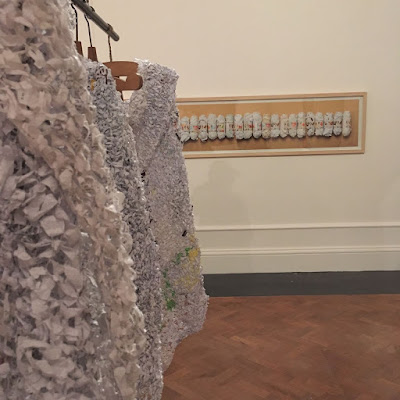Writing
Mid 2011 the idea of ‘The Educators New Clothes’ came to me, it emerged from my art and teaching practice.
My art
practice is primarily concerned with processing matter [material], in a literal
concrete sense, the stuff that collects and appears about me through my living,
and in a figurative way, as the alchemical matter, the dross
[shadow/psychological unfolding] that develops through my being human. What’s
the matter?
Teaching had
taken me through lecturing Design and creative processing at a tertiary
institution, and teaching Design and Visual art at a high school. Over 11 years
I noticed changes in learners’ attitudes and aptitudes. I became increasingly
aware how established learning structures have Learning as their least concern.
How there appears to be a disconnection with information, meaning, skill,
accountability, application and actuality.
I have a
sense of urgency about this, coupled with a feeling of duty.
The move to
public performance places the attention of the piece on the interaction between
the work and the audience. The aim is to encourage opinion, conversation and
discussion around education, that this concern includes everyone. Initially I
wanted to perform in official public civic spaces but after sufficient proposals
were declined, and some really good feedback given to me, the agenda is to take
the work to the streets, to do it everywhere and anywhere.
I feel more
empowered by this as it rubs against people directly, without the interface of
galleries and officialdom. It becomes a part of everyday life, as with
education and learning. I am using social media formats to record the
interactions, encouraging the audience to upload photos and text.
Through my
teaching practice I developed quite a collection of paper. This paper is comprised
of mark sheets, notes, absentee forms, lesson plans, student projects; the
paper that collects through the course of teaching and educating. Much of this
paper could be seen as unnecessary. Many of the procedures and projects which
use these paper forms may be seen as unnecessary, and have very little to do
with learning, and maybe at lot with education. Often the paper can not be
thrown away directly, as it needs to be kept for quality assurance. Some documents
are confidential and may need to be destroyed; procedures and rules which
literally result in substantial volumes of paper.
A few years
ago I was experimenting with paper and knitting and developed a technique which
produced a knittable paper yarn. The technique is to stitch the paper on a sewing
machine with thread, reinforcing the paper, and tearing long lengths which are
then rolled into balls of yarn. The yarn is then knitted on large knitting
needles producing a flexible spreading fabric. These procedures are thus the
‘Menditations’; collecting, stitching, tearing, rolling, knitting.
Learning has
changed dramatically since I was at school. Teachers then represented the
bastions of knowledge. They were the people who knew everything and held access
to all that knowledge. Now google does. There is so much information and yet few
clues on how to make sense of it all. Maybe the ‘what is learnt’ is less important
than the ‘how we learn’ and ‘how it’s done to us’ and ‘how will I go on
learning for the rest of my life once I have the certificate which says I am
capable of doing 30% of something’. I
often felt like a fraud when I taught. The colliding of official procedure and
content, my gut, genuine inspiration and enthusiasm, technology, the historical
and traditional, the new now and contemporary, blossoming minds and accountability;
this piece is making a mends.
Some
reflections on the work:
- Collections of paper: collecting and holding onto stuff which loses and gains significance through time.
- Storing and archiving, sentimentality, procedure and officiousness.
- Flat surfaces which are regular, uniform white and marked in black.
What
is useful, valid and appropriate from the past?
Things can be
mended through stitching. Stitching
can hold things together. There are threads running through everything. The mechanistic industrial thrumming of a
system.
Tearing divides and separates. It makes long
lengths, chains, sequences. It deconstructs and develops new usefulness.
Rolling turns chaotic spaghetti into a new
rounded, compact integrated form.
Knitting develops flexible fabric which adapts
and moulds according to various contexts, whist maintaining its integrity. It
looks intestinal and brain-like. Intelligent assimilation/assimilating
intelligently.


Comments
Post a Comment